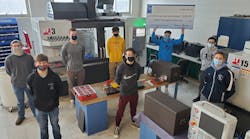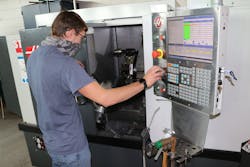There are two types of people: those who have ideas and those who turn those ideas into reality.
Jay Baker, CEO of Jamestown Plastics, along with fellow manufacturer, Randy Stuart, former owner of Stuart Tool and Die, turned their idea into a reality that will have a long-lasting impact on their community in Western New York.
It all began when Baker saw the need for an education system that provided the type of workers that his company, which provides thermoformed products for the automotive, electronics, general industrial and consumer goods sector, needs.
Having been involved for many years in education, as the president of the board of education at age 32, he explored the options available locally and in the region and decided the way to go was to revive the former “shop” training.
But his program had a twist. “Much like schools have Boys and Girls Scout clubs, why not have a manufacturing club? I called Stuart with this crazy idea, and he agreed.” So they started a STEM-focused club for students who want to learn how to “make it” on their own in an advanced manufacturing lab.
The very popular Manufacturer’s Club evolved and was integrated into the curriculum for grades 7 through 12 that goes beyond STEM. And in June of 2018, the Chautauqua Lake Central School opened its new STEM lab to provide students with experience and skills in the field of engineering, technology and applied mathematics. Students are getting a real-world experience as they are taught the process of how to take a concept and create a physical product using CAD (Computer-Assisted Design), Computer-Aided Machining (CAM), and Computer Numerical Control (CNC).
As the program provides high-level skills, students can earn up to 30 credit hours at Rochester Institute of Technology (RIT).
What Has to Change?
Baker said that the parents’ perception of education and expectations of their children has to be expanded. “If a student wanted to do technical training, they were required to be bussed to another location as part of their day and it was complicated and tiring,” he explains. “But when the program is right at the school, it makes it easier and, more importantly, accessible and attractive to more students. This club became the most popular one at school, which shows there is a need for this. As parents, we need to understand what interests our kids and let them follow a route right for them, and not be stuck in our idea of what their education should look like.”
What Baker finds particularly exciting is that the advanced technology gives the students an opportunity to try out these skills. “Introducing this technology at the middle school age is necessary; we don’t need to wait until high school.”
And when students find they have an aptitude for this type of learning, it will eventually allow them to explore careers in manufacturing. Baker cites the example of the valedictorian of the high school in his town that got involved in this program. “He is a brilliant young man, and in his speech, he highlighted the program and said it was the single most important of his education and it inspired him. He said that until he got involved in this program, he had no idea what he wanted to do post-high school and learned he wants to 'make stuff.' He’s now at RIT working on his master’s degree in engineering.”
A Blueprint for Education
Where technical education used to be considered a program for those who weren’t proficient at academics, it’s now the best and brightest students who are doing the STEM curriculum, says Baker.
Baker notes that some kids who were bored at school, have blossomed in this program. “These kids are bright and motivated and now they have an outlet for their talent,” says Baker.
Baker and Stuart hope to use Chautauqua’s program as a model for other school districts across the state – and maybe even the nation.
“We have created a blueprint that shows manufacturers how they can impact educators,” Baker explains. “While kids are learning how to make things, they are also learning problem-solving and critical-thinking skills which are needed not only in manufacturing but in any career path.”







